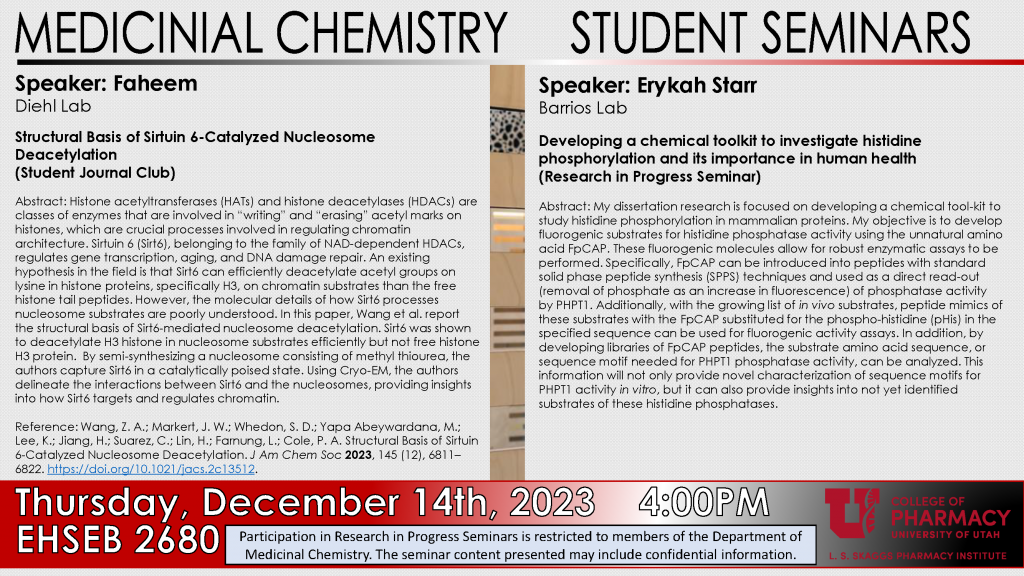Medicinal Chemistry Student Seminars


Speaker: Faheem
Diehl Lab
Structural Basis of Sirtuin 6-Catalyzed Nucleosome
Deacetylation
(Student Journal Club)
Abstract: Histone acetyltransferases (HATs) and histone deacetylases (HDACs) are
classes of enzymes that are involved in “writing” and “erasing” acetyl marks on
histones, which are crucial processes involved in regulating chromatin
architecture. Sirtuin 6 (Sirt6), belonging to the family of NAD-dependent HDACs,
regulates gene transcription, aging, and DNA damage repair. An existing
hypothesis in the field is that Sirt6 can efficiently deacetylate acetyl groups on
lysine in histone proteins, specifically H3, on chromatin substrates than the free
histone tail peptides. However, the molecular details of how Sirt6 processes
nucleosome substrates are poorly understood. In this paper, Wang et al. report
the structural basis of Sirt6-mediated nucleosome deacetylation. Sirt6 was shown
to deacetylate H3 histone in nucleosome substrates efficiently but not free histone
H3 protein. By semi-synthesizing a nucleosome consisting of methyl thiourea, the
authors capture Sirt6 in a catalytically poised state. Using Cryo-EM, the authors
delineate the interactions between Sirt6 and the nucleosomes, providing insights
into how Sirt6 targets and regulates chromatin.
Reference: Wang, Z. A.; Markert, J. W.; Whedon, S. D.; Yapa Abeywardana, M.;
Lee, K.; Jiang, H.; Suarez, C.; Lin, H.; Farnung, L.; Cole, P. A. Structural Basis of Sirtuin
6-Catalyzed Nucleosome Deacetylation. J Am Chem Soc 2023, 145 (12), 6811–
6822. https://doi.org/10.1021/jacs.2c13512.
Speaker: Erykah Starr
Barrios Lab
Developing a chemical toolkit to investigate histidine
phosphorylation and its importance in human health
(Research in Progress Seminar)
Abstract: My dissertation research is focused on developing a chemical tool-kit to
study histidine phosphorylation in mammalian proteins. My objective is to develop
fluorogenic substrates for histidine phosphatase activity using the unnatural amino
acid FpCAP. These fluorogenic molecules allow for robust enzymatic assays to be
performed. Specifically, FpCAP can be introduced into peptides with standard
solid phase peptide synthesis (SPPS) techniques and used as a direct read-out
(removal of phosphate as an increase in fluorescence) of phosphatase activity
by PHPT1. Additionally, with the growing list of in vivo substrates, peptide mimics of
these substrates with the FpCAP substituted for the phospho-histidine (pHis) in the
specified sequence can be used for fluorogenic activity assays. In addition, by
developing libraries of FpCAP peptides, the substrate amino acid sequence, or
sequence motif needed for PHPT1 phosphatase activity, can be analyzed. This
information will not only provide novel characterization of sequence motifs for
PHPT1 activity in vitro, but it can also provide insights into not yet identified
substrates of these histidine phosphatases.
Published in Student Affairs